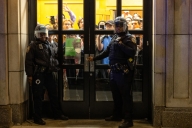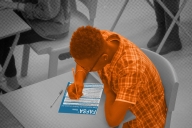You have /5 articles left.
Sign up for a free account or log in.
A Long Island district attorney on Tuesday announced that the College Board and the ACT had agreed to tighter security measures for those taking the SAT and the ACT. Nassau County authorities have charged 20 people with involvement in schemes in which supposed test-takers paid others to take the SAT for them. Among the new rules:
- Test registrants will be required to upload a photograph of themselves when they register for the SAT or ACT. The photo will be printed on admissions tickets and the test site roster, and checked against the photo ID registrants provide at the test center, and the photo will accompany students’ scores as they are reported to high schools and colleges.
- Uploaded photos will be retained in a database available to high school and college admissions officials.
- All test registrants will be required to identify their high school during registration so that high school administrators receive students’ scores as well as their uploaded photos.
- All test registrants will provide their date of birth and gender, which will be printed on the test site roster.
- Standby test registration will be eliminated.
- Students will certify their identity in writing at the test center, and acknowledge the possibility of a criminal referral and prosecution for engaging in criminal impersonation.
- Proctors will check students’ identification more frequently at test centers. IDs will be checked upon entry to the test center, re-entry to the test room after breaks, and upon collection of answer sheets.
Kathleen M. Rice, the Nassau County district attorney, said that "these reforms close a gaping hole in standardized test security that allowed students to cheat and steal admissions offers and scholarship money from kids who played by the rules."
Bob Schaeffer, public education director of the National Center for Fair & Open Testing (a critic of standardized testing), said that the new system "is likely to reduce significantly, if not eliminate entirely, the likelihood of impersonators entering an exam center." But he added that the new measures do "nothing" for "much more common types of cheating: collaboration among students once they are inside the test site or copying answers as the result of wandering eyeballs." He also questioned why the enhanced security rules, which he said were "technically feasible at least a decade ago," were adopted only after the Nassau County investigations.








